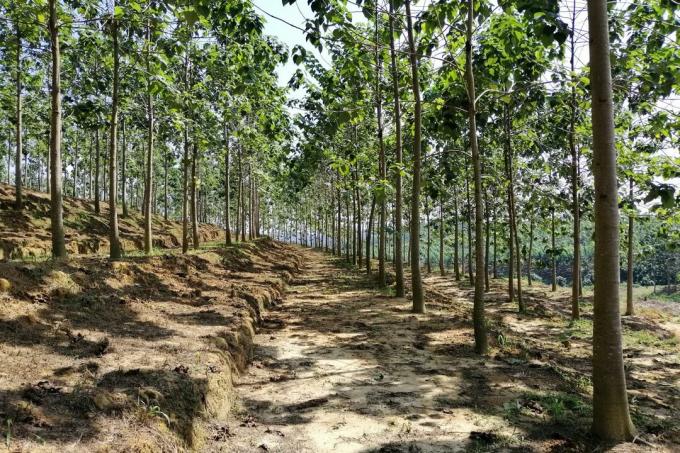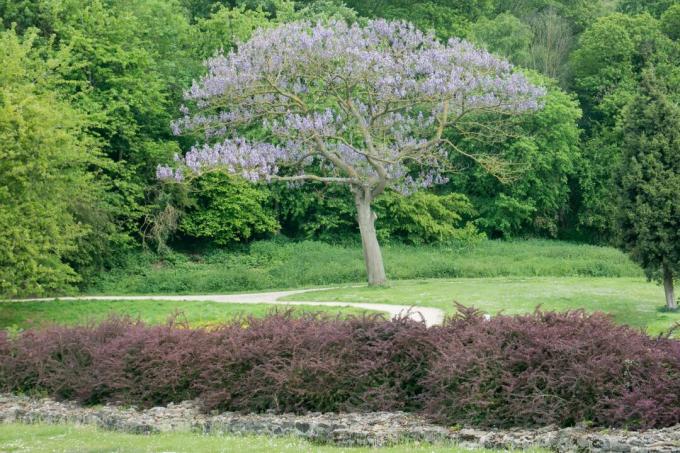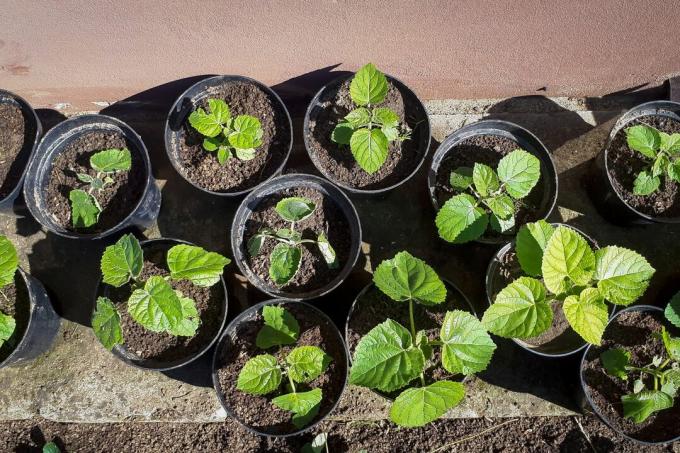Is it worth buying a kiri tree (paulownia) for your own garden and how is it cared for? We answer these and other questions in this article.

The Kiri Tree (Paulownia tomentosa), also called paulownia, is a feast for the eyes in every garden. He loves a warm climate and drought doesn't bother him much. We explain how to plant, care for and prune the paulownia tree with the purple-blue flowers.
contents
- Paulownia: flowering time, origin and properties
- The most famous Paulownia species and varieties
- Plant paulownia in the garden
-
Paulownia care: This is something to consider
- Water and fertilize
- Cutting paulownia
- multiply paulownia
- Are paulownias hardy?
- Are paulownia poisonous?
Paulownia: flowering time, origin and properties
The blue-violet flowers of the paulownia are a real feast for the eyes of every garden lover. The paulownia tree, also known as the blue bell tree, kiri tree or emperor tree, is a deciduous tree native to China and Taiwan. The plants are part of the Paulowniaceae family and have strikingly thick, stiff, grey-felted shoots. When the plants flower between April and May, the entire crown is covered with flower spikes that are around 20 cm long. These often consist of up to 30 individual flowers, which are very large with a length of 3 to 12 cm. Only after flowering do the huge, light green leaves, up to 40 cm in size, appear, which provide plenty of shade in summer.
The plants come from warm regions and are therefore well adapted to hot urban climates. They can also cope with longer periods of heat and drought. In Germany, they get along very well in wine-growing regions, but in winter-cold regions, the flower buds can freeze and the blossoms are absent. Planted as a single tree, a paulownia can reach a height of up to 15 m. Because of the rapid growth in the juvenile phase, paulownias are also called "climate tree“, because they produce a lot of CO in a short time2 from the atmosphere and are better adapted to climate change than most native woody species.

The most famous Paulownia species and varieties
There are several Paulownia species on the market, which differ primarily in terms of their sensitivity to frost. The most well-known are:
- Bluebell tree wild species (Paulownia tomentosa): Mature trees also tolerate low temperatures, but young plants in particular should be well protected from frost. The plants grow quickly when young and often look very picturesque when old.
- Bluebell Tree Hybrid (Paulownia tomentosa ‘NordMax21®’): This hybrid cross has been bred specifically for the European climate and can tolerate temperatures up to
– 22°C. Striking for this variety is an upright and particularly fast growth.

In addition to these two species, there are other Paulownia species that are not suitable for cultivation in the home garden. They are mainly used for the production of high quality wood.
Plant paulownia in the garden
Paulownias are sold in many different forms. From cuttings to bare-rooted one- to two-year-old trees to perennial plants as high-quality bales or in pots, there is the right plant for every need and budget available.
Location: A sunny location with well-drained soil is ideal for the Kaiserbaum. Care should be taken that the soil is not too moist and nutrient-rich, otherwise the wood will grow too "masty" and susceptible to frost. The pH range of the soil should be in the slightly acidic to slightly alkaline environment (6.5 - 7.5). If the soil is too acidic, the pH can be adjusted by adding garden lime be lowered. Sand should be worked into very heavy, clayey soils to avoid waterlogging and long periods of moisture. On sandy soils, it is advisable to work in slightly rotted compost or potting soil. Our Plantura organic universal soil With a pH value between 6.1 and 6.9, it is ideal for planting paulownias and many other shrubs and perennials. The organic soil is completely peat-free - this reduces CO2-balance compared to conventional soils by up to 60%.

Instructions for planting a kiri tree:
- Time: Small plants only after mid-May, perennial bales from March.
- Planting distance: 4 m distance to other trees, so that the picturesque growth can unfold.
- Planting hole: 1.5 times the size of the root ball.
- If necessary, mix the soil in the planting hole with sand or mature compost.
- Procedure: Put the blue bell tree in the hole; the root collar should be just above ground level; press firmly; model a pouring rim with excess soil and water extensively.
The cultivation of Paulownia in the tub is only recommended in the first few years. The plants are very vigorous and the roots grow very deep, so permanent cultivation in pots is not suitable.
tip: Paulownias like to be bitten by game such as rabbits or deer. In areas with a high occurrence of these animals, it makes sense to attach a bite protection. Incidentally, the non-toxic leaves can also be used as animal feed for livestock.
Paulownia care: This is something to consider
The blue bell tree is very easy to care for. You can find out the most important care measures and their timing below.
Water and fertilize
In the phase shortly after planting, an adequate water supply should be ensured. Once established, the Paulownia tree copes well with drought. Paulownias usually do not need to be fertilized. If the soil is extremely poor in nutrients, fertilization should be carried out before June. If you fertilize too much, especially with nitrogen, the branches will otherwise become more susceptible to frost damage in winter.

Cutting paulownia
Paulownia trees naturally form a main trunk that grows more or less straight, depending on the species. A cut is not absolutely necessary. If frost damage is visible, the dead shoots can be generously removed. By "pruning" you create a kind of avenue tree with a long trunk. To do this, the young side shoots are regularly removed until the desired crown height is reached. Alternatively, pruning can be dispensed with in order to obtain a more deeply branched, pyramid-shaped tree. In order not to remove flower buds, it is advisable to plan the pruning after flowering.

multiply paulownia
The Kiri tree can be propagated by root cuttings, seeds or sticks. Sticks are particularly suitable because the trees grow faster and better. For the propagation of paulownias, 20 to 30 cm long sticks of the latest shoots are cut off in autumn. These are cut at an angle at the base and then placed in potting soil in such a way that only the two upper buds look out of the substrate. A loose, low-nutrient substrate, ideally cuttings soil, is perfectly suited to achieve good rooting of the cuttings. Our Plantura Organic Herb & Seed Soil is ideal for this because it is loosened up with perlite and has the right nutrient content. After the cuttings are in the ground, they should be watered vigorously. The young plants are best brought to a frost-free place over the winter. However, living spaces are not suitable for this due to the heat and dryness of the air.

Are paulownias hardy?
Most Paulownia species are hardy when fully grown. In sheltered locations and in wine-growing regions, hardly any frost damage is to be expected, even in younger plants. In cold winter regions, however, plants in pots should be overwintered in a frost-free but still cold place.
Are paulownia poisonous?
Paulownia fruits are reminiscent of hazelnuts, but are not suitable for consumption. They are classified as slightly toxic. For small children and pets, they are usually not particularly attractive, so that there is usually no danger to be feared. The paulownia leaves are non-toxic. They are even prepared as a dish in some Asian countries.
In addition to the blue bell tree, magnolias are also famous for their lush flowers. Like the white to pink flowers magnolias care, pruning and propagation, you will learn in this article.



